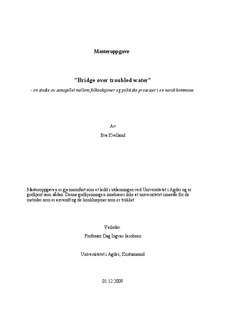| dc.description.abstract | Participation in the political arena has changed over time in both form and scope. While we
previously considered elections and party policy as the most important channels for political
influence, in the last decades we have registered a trend towards more direct forms of
participation. The last Norwegian power and democracy study (2003) concludes that this
trend contributes to a decline of democracy. The purpose of this paper has been twofold. First
and foremost, I have with help of a case study, researched the interaction between one
specific civic action and the consequent official political processes within a limited period of
time. Secondly, I have with regard to the papers theoretical foundation, discussed the findings
of the study in relation to the conflicting points between direct and representative democracy.
The theoretical background for the paper is divided in two. Using among other things, the
results and the empirical data presented in the power and democracy study from 2003, I have
made a number of assumptions about how activism as a form of political participation relates
to the formal processes, as well as the characteristics of actions, the actors and what effects
they are believed to have on the outcome of political processes. In order to use task findings
to discuss the relationship between direct and representative democracy, I have included Ian
Budge’s arguments for and against direct participation
To answer the main question of this paper, I have conducted a time-limited case study of the
conflict-driven construction of a pedestrian- and bicycle-bridge in the municipality of Mandal.
The basis for empirical data is gathered through document analyses of both articles from the
media and municipal documents. As a form of analysis I have used process analysis, to be
able to describe how something occurs, changes and evolves over time.
The analysis of the data reveals a process with a number of actors involved in the interaction,
where activity levels and intensity largely are governed by fixed political events. I have
described the lifecycle of the process phases, and conclude that public actions and political
processes develop simultaneously but independent of one another, only to meet on common
arenas when decision-time is approaching. Finally, I have made a comparison and discussion
of the results and arguments for and against direct democracy. After studying my individual
case I question whether the reaction channel at all has influence on the outcome of a case, or
if it only affects what is put on the agenda and what kind of form and content the political
debate has. Last, but not least, I discuss the question; is this really a democratic problem? | en_US |
